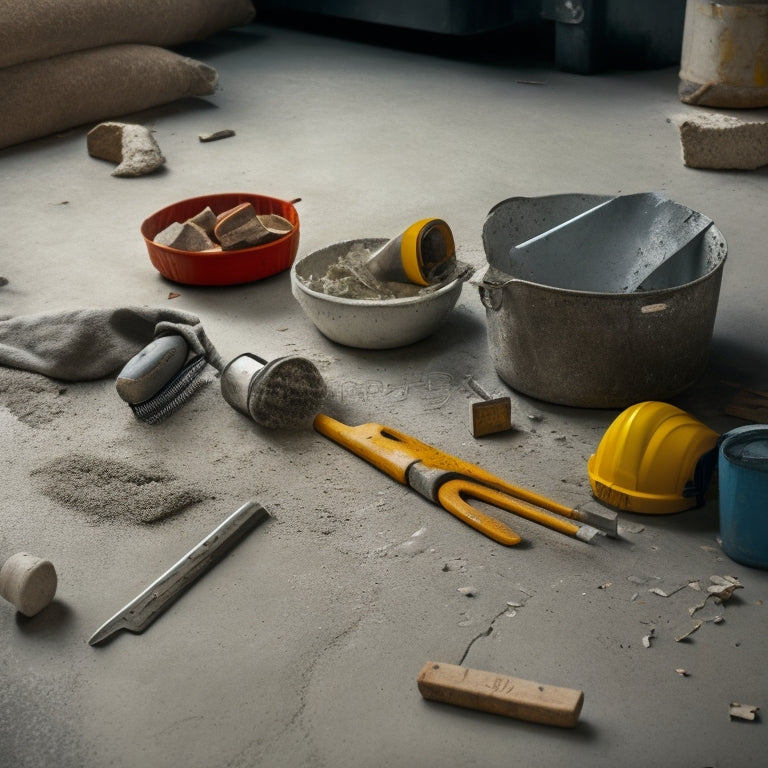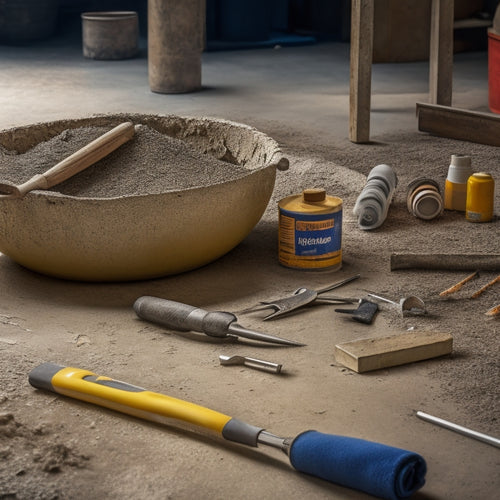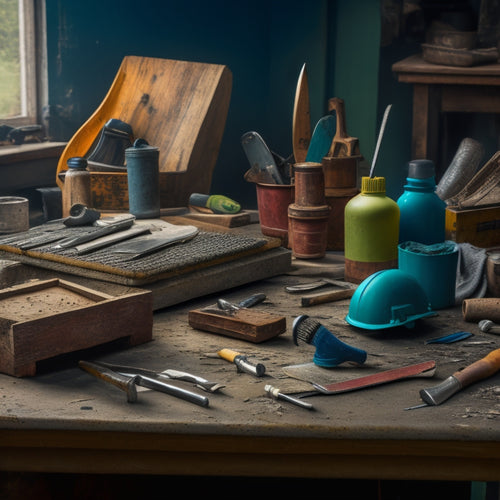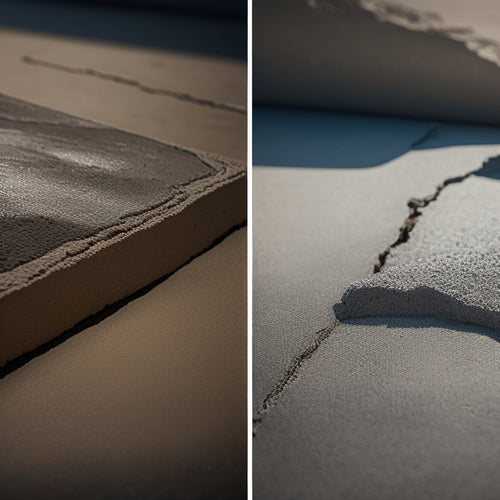
Top 10 Concrete Repair Tools for Small Fixes
Share
You'll need the right tools to tackle small concrete repairs efficiently and effectively. When it comes to small fixes, having the top 10 concrete repair tools at your disposal will guarantee your fixes are long-lasting and professional-looking. Quick Fix Concrete Patching Trowels, Epoxy Injection Gun Kits, and Concrete Crack Chaser Blades are must-haves for crack and void repair. Handheld Concrete Grinders and Polyurethane Foam Injectors are also essential for surface preparation and filling gaps. Rounding out the list are Rapid Set Concrete Mixers, Concrete Hole Drilling Bits, Self-Leveling Compound Spreaders, and Concrete Surface Smootheners. With these tools, you'll be well-equipped to tackle any small concrete repair - and exploring their uses will take your skills to the next level.
Key Takeaways
• For small concrete repairs, Quick Fix Concrete Patching Trowels are ideal for rapid repairs of small cracks and holes.
• Concrete Floor Scraper Tools are essential for removing old coatings, adhesives, or debris for a clean surface preparation.
• Self-Leveling Compound Spreaders simplify the leveling process, leading to higher quality repairs, and are suitable for small to large areas.
• Epoxy Injection Gun Kits are useful for deeper, extensive cracks requiring robust repairs, and are effective for filling voids in walls, floors, and ceilings.
• Concrete Surface Smootheners, such as Tamping Tools, Bull Floats, and Hand Floats, are necessary for achieving a dense finish and quality surface preparation.
Quick Fix Concrete Patching Trowels
You'll reach for a quick fix concrete patching trowel when you need to rapidly repair small cracks and holes in concrete surfaces. This versatile tool is designed for fast, effective repairs, allowing you to restore damaged areas to their original state.
When selecting a patching trowel, consider the type of patching materials you'll be working with, as this will influence your choice of trowel size, shape, and material.
Mastering trowel techniques is essential for achieving a seamless repair. Hold the trowel at a 45-degree angle, applying gentle pressure to spread the patching material evenly. Use long, smooth strokes to fill the crack or hole, feathering the edges to blend with the surrounding concrete.
For larger repairs, use a trowel with a notched edge to apply the material in thin layers, allowing each layer to set before adding the next. By combining the right patching materials with expert trowel techniques, you'll be able to complete small concrete repairs with confidence and precision.
Epoxy Injection Gun Kits
When deeper, more extensive cracks require a more robust repair, epoxy injection gun kits come into play, offering a powerful solution for injecting epoxy resin into narrow cracks and voids in concrete structures.
You'll find these kits particularly useful for repairing cracks in walls, floors, and ceilings, as well as filling voids behind walls and under slabs.
To get the most out of your epoxy injection gun kit, it's crucial to master epoxy application techniques. This includes properly preparing the surface, mixing the epoxy resin, and injecting it into the crack or void at the right pressure.
Be sure to follow the manufacturer's instructions for adhesive curing times, as this can vary depending on the specific product and environmental conditions.
A good epoxy injection gun kit should include a high-pressure gun, injection ports, and a selection of nozzles and packs.
Look for a kit that allows for precise control over the injection process, ensuring you can fill even the smallest cracks and voids with ease.
With the right kit and techniques, you'll be able to achieve professional-quality results and extend the lifespan of your concrete structures.
Concrete Crack Chaser Blades
Cutting through concrete to create a clean, precise edge around cracks prepares the surface for effective repair, and that's where concrete crack chaser blades come in. These specialized blades are designed to remove damaged or deteriorated concrete, allowing you to create a solid foundation for your repair.
When selecting a concrete crack chaser blade, consider the type of concrete you're working with, as well as the width and depth of the crack. A diamond-coated blade is ideal for most concrete crack repair applications, as it provides a smooth, consistent cut. Blade selection tips also include choosing a blade with the appropriate arbor size and RPM range for your specific saw or grinder.
For smaller cracks, you may opt for a narrower blade, while larger cracks require a wider blade for efficient removal of material. Additionally, consider the quality of the blade's construction, as a high-quality blade will last longer and perform more consistently.
Handheld Concrete Grinders
With the crack's edges cleanly cut and prepared, you're ready to switch to a handheld concrete grinder to further refine the surface and create a strong bond between old and new concrete. This versatile tool offers numerous handheld grinder benefits, including increased precision and control. Its portability allows for easy maneuverability in tight spaces, making it ideal for portable grinding applications.
When selecting a handheld grinder, consider the type of concrete you're working with and the level of aggressiveness required. A grinder with adjustable speed and variable handle positions will provide more versatility and comfort during extended use.
When operating the handheld grinder, maintain a consistent motion, working in small sections to avoid creating swirl marks. Apply moderate to heavy pressure, depending on the concrete's hardness, and avoid applying too much pressure, which can create scratches or damage the surrounding area.
Polyurethane Foam Injectors
You'll need a polyurethane foam injector to fill the crack or void with a high-strength, flexible material that bonds well with concrete. This tool is essential for repairing cracks, holes, and joints in concrete structures. With a polyurethane foam injector, you can guarantee a strong and durable bond between the foam and the surrounding concrete.
| Polyurethane Benefits | Foam Application Techniques |
|---|---|
| High-strength and flexible | Low-pressure injection |
| Bonds well with concrete | High-pressure injection |
| Resistant to water and chemicals | Hand-mixing and pouring |
| Expands to fill gaps and voids | Injection through ports or holes |
| Suitable for various concrete types | Cleaning and preparing the surface |
When using a polyurethane foam injector, it's vital to follow proper foam application techniques to achieve the best results. This includes selecting the right type of polyurethane foam, preparing the surface, and using the correct injection method. By mastering these techniques, you can guarantee a successful repair that lasts for years to come.
Concrete Floor Scraper Tools
After filling cracks and voids with polyurethane foam, prepare the surrounding concrete floor by removing old coatings, adhesives, or debris with a concrete floor scraper tool, a must-have for any successful concrete repair project.
This tool is essential for concrete floor maintenance, as it allows you to start with a clean slate before applying new coatings or finishes.
When using a concrete floor scraper tool, remember to:
-
Choose the right scraper: Select a scraper that's appropriate for the type of debris you're removing, such as a heavy-duty scraper for thick coatings or a lighter scraper for smaller areas.
-
Work in small sections: Divide the floor into smaller sections to maintain control and avoid spreading debris around.
-
Use proper scraper tool techniques: Hold the scraper at a 45-degree angle and apply gentle to moderate pressure, depending on the type of debris you're removing.
Rapid Set Concrete Mixers
By the time you're ready to mix and apply new concrete, every minute counts, which is why Rapid Set Concrete Mixers are a game-changer in the world of concrete repair.
These mixers are designed to get the job done quickly and efficiently, allowing you to focus on the task at hand. With advanced mixing techniques, Rapid Set Concrete Mixers guarantee a consistent and strong concrete mix, every time. Plus, their portability features make them easy to transport to any job site, no matter how remote.
When working with Rapid Set Concrete Mixers, you can expect a fast-setting mix that's ready to use in as little as 15 minutes. This means you can get back to work sooner, completing your project in record time.
The mixers' compact design and lightweight construction also make them easy to handle and maneuver, reducing fatigue and strain.
Whether you're a seasoned pro or a DIY enthusiast, Rapid Set Concrete Mixers are the perfect tool for any small concrete repair job. With their speed, efficiency, and portability, you'll be able to tackle even the most intimidating tasks with confidence.
Concrete Hole Drilling Bits
When you're tasked with drilling holes in concrete, you need the right bits for the job.
You'll want to contemplate the type of material your drill bits are made of, as well as the range of hole sizes you can achieve with them.
From there, you'll need to think about the factors that affect bit durability, so you can make informed decisions about your concrete hole drilling bits.
Drill Bit Materials
You'll find that concrete hole drilling bits are typically made from three primary materials: tungsten carbide, diamond-coated, and steel, each with its unique characteristics, advantages, and limitations.
When it comes to selecting the right drill bit material for your concrete repair project, understanding the strengths and weaknesses of each is vital. Here are some key points to take into account:
-
Tungsten Carbide Bits: These bits are made from carbide steel and are ideal for drilling through concrete with rebar or other hard aggregates. They're durable and resistant to wear, but can be brittle and prone to breakage.
-
Diamond-Coated Bits: Diamond-tipped bits are designed for drilling through hard concrete and are extremely aggressive. They're perfect for projects that require high-speed drilling and can withstand heavy use.
-
Steel Bits: Steel bits are the most affordable option and are suitable for drilling through soft concrete. However, they're prone to wear and may not be effective for projects that require drilling through hard aggregates.
Hole Size Options
Your concrete hole drilling project requires bits that can handle specific hole sizes, and selecting the right one is crucial to achieving accurate results and minimizing waste.
You'll need to take into account the hole dimensions required for your repair, as well as the type of patch material you'll be using. Different materials, such as epoxy or polyurethane, have varying thicknesses and flow rates, which affect the size of the hole needed.
When choosing a drill bit, you'll want to select one that can create a hole with a diameter that matches the thickness of your patch material. If you're using a thicker material, you'll need a bit that can create a larger hole. Conversely, thinner materials require smaller holes.
It's also important to take into account the depth of the hole, as you'll want to confirm the bit can drill to the correct depth for a secure bond between the patch material and the surrounding concrete.
Bit Durability Factors
Selecting a concrete hole drilling bit that can withstand the rigors of your repair project depends on several key durability factors, including the bit's material, coating, and design features. You want a bit that can resist wear and tear, maintain its cutting edge, and deliver consistent results.
Here are three critical factors to evaluate when examining a bit's durability:
-
Material quality: Look for high-carbon steel or tungsten carbide, which offer superior strength and resistance to wear.
-
Coating and surface treatment: A durable coating, such as titanium nitride or diamond, can reduce friction and enhance the bit's cutting ability.
-
Design features: A well-designed bit with optimized flute geometry and cutting angles can improve bit performance and extend its lifespan.
Self-Leveling Compound Spreaders
When you're working with self-leveling compound spreaders, you'll appreciate the importance of achieving even surfaces.
That's why you'll want to opt for spreaders that guarantee even surfaces, ensuring your concrete repairs meet the highest standards.
With these tools, you'll also appreciate the easy cleanup design, which saves you time and hassle on the job site.
Even Surfaces Guaranteed
You'll typically reach for self-leveling compound spreaders to achieve perfectly even surfaces in a fraction of the time it takes with traditional methods. These tools are designed to simplify surface preparation techniques, allowing you to focus on the repair itself rather than spending hours leveling the substrate.
When choosing a self-leveling compound spreader, consider the following leveling compound options:
-
Rake-style spreaders: Ideal for large areas, these spreaders feature a long handle and a wide, toothed blade that allows for efficient spreading and leveling.
-
Trowel-style spreaders: Better suited for smaller areas, these spreaders resemble a large trowel and provide more control over the spreading process.
-
Paddle-style spreaders: A hybrid of the two, paddle-style spreaders offer a balance between efficiency and control, making them a popular choice among professionals.
Easy Cleanup Design
With self-leveling compound spreaders chosen, it's time to contemplate the importance of easy cleanup design, which can greatly reduce the time and effort spent on post-repair tasks.
You'll want to ascertain that your spreader is designed with cleanup efficiency in mind. Look for features like removable mixing paddles, easy-to-clean surfaces, and mess-reducing edges. These features will save you time and energy when it comes to cleaning up after a job.
When evaluating spreaders, consider the materials used in their construction. Durable, rust-resistant materials will withstand the rigors of cleaning and last longer.
Additionally, consider the spreader's design and layout. A well-designed spreader will minimize the amount of compound that gets stuck in crevices, making cleanup a breeze.
Concrete Surface Smootheners
Effective concrete surface smootheners, like tamping tools and bull floats, help you achieve a uniform, even finish by removing imperfections and air pockets from freshly poured concrete.
As you work on small fixes, you'll find that these tools are essential in mastering concrete finishing techniques. By using them, you'll be able to achieve a smooth, even surface that's perfect for painting, coating, or leaving as is.
Here are three surface smootheners you should consider:
-
Tamping tools: Great for removing air pockets and excess water from the surface, tamping tools help you achieve a dense, even finish.
-
Bull floats: These long, flat tools are perfect for smoothing out large areas of concrete, removing imperfections and leaving a smooth finish.
-
Hand floats: For smaller areas or tight spaces, hand floats are ideal for smoothing out concrete and preparing it for further surface preparation methods.
Frequently Asked Questions
Can I Use a Concrete Repair Tool on a Freshly Poured Slab?
When you're dealing with a freshly poured slab, it's crucial to let it complete the curing process before using a concrete repair tool.
You shouldn't apply any tools until the slab has fully hardened, which can take anywhere from 24 hours to 28 days, depending on the mix and environmental conditions.
Premature repair attempts can compromise the slab's integrity, leading to further damage or structural issues.
Are Concrete Repair Tools Suitable for DIY or Professional Use Only?
You're wondering if concrete repair tools are only for the pros or if DIY enthusiasts can get in on the action too.
Let's debunk the myth: these tools aren't exclusive to either camp. While professionals may have more experience, DIYers can still benefit from using them, especially for small fixes.
In fact, many DIY advantages lie in cost-effectiveness and hands-on learning.
However, for more complex repairs, it's recommended to seek professional recommendations to guarantee a job well done.
How Long Does It Take for Concrete Repairs to Fully Cure?
When you're tackling concrete repairs, you're probably wondering how long it takes for them to fully cure.
The curing time largely depends on the repair method you're using.
Generally, most concrete repairs take anywhere from 24 hours to 28 days to fully cure, with some epoxy-based methods taking up to 7 days.
You'll need to wait for the recommended curing time before putting the repaired area back into service.
Can I Paint Over Repaired Concrete Surfaces Immediately?
You shouldn't paint over repaired concrete surfaces immediately.
In fact, you'll need to wait until the repair material has fully cured, which can take anywhere from a few hours to several days, depending on the product and environmental conditions.
Once cured, you'll need to prepare the surface for painting by cleaning and sanding it to guarantee a strong bond.
Then, you can apply your chosen painting techniques, but only after proper surface preparation to achieve a durable, long-lasting finish.
Are Concrete Repair Tools Compatible With All Types of Concrete?
As you venture into the world of concrete repair, you're like a master builder constructing a sturdy foundation.
But, can you guarantee your tools are compatible with all types of concrete? The answer lies in understanding the diverse concrete types and their unique properties.
From high-flow to self-consolidating, each type demands specific repair methods. You'll need to choose tools that adapt to these variations, guaranteeing a seamless bond between old and new concrete.
Conclusion
You've got the top 10 concrete repair tools for small fixes in your arsenal, and you're ready to tackle that cracked sidewalk or uneven floor.
But the question is, what's next? Will you be able to tackle the next big project that comes your way, or will you be stuck calling in a professional?
With these tools, the answer is clear: you'll be the one in control, fixing it like a pro and moving on to the next challenge.
Related Posts
-

Top Tools for Repairing Cracked Concrete Surfaces
When tackling a cracked concrete surface repair, you'll need the right tools to guarantee a durable fix. Start with e...
-

Must-Have Handheld Tools for Concrete Repair
When tackling a concrete repair project, it is crucial to have the right handheld tools to achieve a professional fin...
-

What Tools Ensure Strong Concrete Adhesion at Home
You'll need the right tools to guarantee strong concrete adhesion at home. For surface preparation, use concrete surf...


